
* Helicopter gunships tend to be ugly machines that look like something out of science-fiction movies, projecting menace and firepower instead of grace and elegance. One good example of the style is the Boeing (previously McDonnell Douglas and originally Hughes) "AH-64 Apache" gunship, the mainstay of the US Army's attack helicopter force, also in service with several foreign nations. This document provides a history and description of the Apache. A list of illustration credits is provided at the end.
* In the 1960s, the US Army pinned its hopes for a front-line attack helicopter on the advanced Lockheed AH-56 Cheyenne gunship, adopting the less sophisticated Bell AH-1 Cobra as an interim solution until the Cheyenne became available. Like many interim solutions, the Cobra would remain in service for far longer than originally expected -- since in the end, the Cheyenne proved to not be quite the machine that the Army really wanted. It was a hefty, powerful "flying tank" that put a premium on raw speed and firepower at the expense of agility and treetop operation. The Army decided that a somewhat smaller and more maneuverable gunship would be more survivable.
The fall of the Cheyenne program led the Army to issue a new request for proposals (RFP) for an "Advanced Attack Helicopter (AAH)" in August 1972. Five manufacturers submitted designs, and on 22 June 1973 the Bell "Model 409 /YAH-63" and the Hughes "Model 97 / YAH-64" were selected as finalists. Each contractor was to build two flight prototypes and a ground-test machine for evaluation.
Bell believed their YAH-63 was the front-runner because of the company's proven experience with the Cobra, and in fact their contender was basically a bigger and badder Cobra. The initial YAH-63 prototype performed its first flight on 1 October 1975, with the second machine flying on 21 December.
The first Hughes YAH-64 actually beat the first Bell prototype into the air by one day, performing its initial flight on 30 September 1975. The second YAH-64 performed its initial flight on 22 November 1975. The Army put all four machines through an intensive test program. A separate competition was conducted for the sensor and targeting suite for the AAH, with Martin Marietta and Northrop submitting proposals in November 1976.
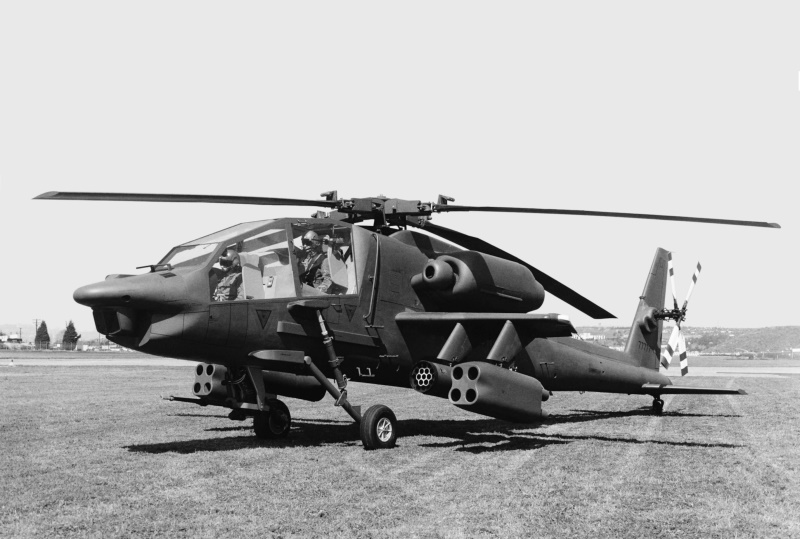
Late in the prototype evaluation, the Army threw Bell and Hughes a curve ball by changing the specification for the primary antitank weapon for the AAH from the proven TOW wire-guided missile to the new Hellfire laser-guided missile, with longer range and heftier killing power than TOW. This was risky because Hellfire hadn't even been flown at the time, with the initial development contract with Rockwell International signed in October 1976.
* In any case, the Hughes YAH-64 was declared as the winner on 10 December 1976. Both designs were regarded as very good, but the Hughes design seemed to have an edge in survivability. The "Phase 2" development program funded development of three pre-production "AH-64s", as well as bringing the two YAH-64 flight prototypes and the ground test machine up to the same specification.
The Phase 2 program suffered through a number of delays for various reasons and stretched out to over five years. First Phase 2 flight, of an upgraded initial prototype, was on 28 November 1977, with first flight of a new-build pre-production prototype on 31 October 1979. Initial Hellfire launches had already taken place by that time, with first firings in April 1979. A competitive evaluation of pre-production machines, one fitted with the Martin Marietta sensor / targeting suite and the other fitted with the Northrop suite, was performed, with Martin Marietta winning the competition in April 1980.
An initial production order for 11 "AH-64A Apache" attack helicopters was finally issued on 26 March 1982, with a follow-on order for 48 more machines delayed until the government and Hughes could work out some differences. The first production machine was formally rolled out at the Hughes factory in Mesa, Arizona, on 30 September 1983. An Apache tribesman, in native dress and on horse with a Winchester rifle, helped honor the occasion -- though embarrassingly, the Hughes in-house newspaper failed to report his name while listing every other person of importance who attended.
* Initial production hand-over to the US Army was on 26 January 1984, with the machine painted in dark green colors that would become standard for the Apache. By that time, the helicopter had become the "McDonnell Douglas (MDD) Apache" since MDD had bought out Hughes Helicopters in December 1983. MDD was bought out in turn by Boeing in the late 1990s, and so the machine is now the "Boeing Apache".
The AH-64A reached formal operational status with the US Army in July 1986, and went into service with the Army National Guard in 1989. The Army initially planned to buy 536 Apaches. Rising costs of the type ended up forcing cutbacks to 436 machines, but additional procurement eventually led to acquisition of 807 machines by 1994, not counting the six prototypes. A number of attrition replacement machines were also ordered, bringing the total of US Army production AH-64As to 821, with final deliveries in 1996.
BACK_TO_TOP* The AH-64A defined a baseline for the series. The AH-64A was of conventional configuration for a modern attack helicopter. It had a main-tail rotor arrangement, a tandem-seat cockpit, nose-mounted sight, and two stub wings with a total of four pylons for underwing stores. The airframe was made mostly of aircraft aluminum alloys, but was designed to withstand 12.7-millimeter (0.50-caliber) projectile hits from all quarters, and could tolerate 23-millimeter projectile hits. A "wire strike protection system (WSPS)" was fitted, with six cutters and eleven deflectors protecting the machine from collisions with telephone lines and power cables.
The gunner sat in the forward seat and the pilot in the rear seat, which was raised 49 centimeters (19 inches) to give the pilot a view over the gunner's head. The gunner's position had simple backup flight controls; the gunner was formally referred to as the "Co-Pilot / Gunner (CPG)". Both crew were protected by boron armor shields lining the cockpit, and their kevlar seats were designed to help absorb the shock of a crash landing.
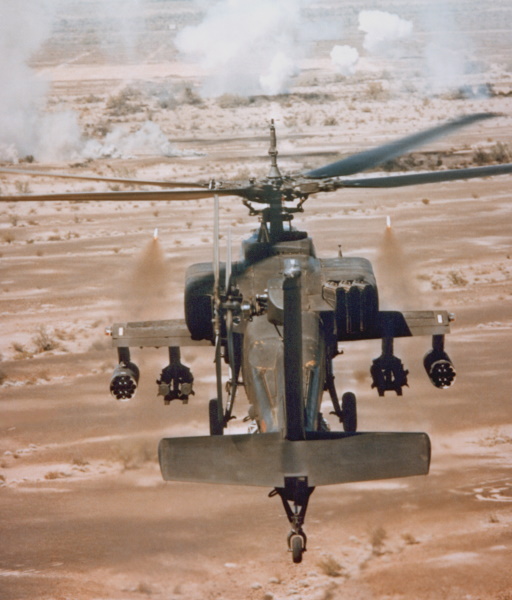
The AH-64A had fixed tailwheel landing gear, with the main gear on heavy-duty shock mounts for survivability in hard landings; on really hard landings, the main gear struts collapsed in a controlled fashion to further soften the impact. The landing gear could "kneel" to ease transport of the helicopter. The seats and the landing gear provided a surprising amount of crew protection, as demonstrated by one of the prototype machines that suffered a catastrophic engine failure at an altitude of about 90 meters (300 feet). The crew walked away from the crash, banged up but not seriously injured.
The crew got into and out of the cockpit through upward-hinging canopy panels. Various handholds and steps were fitted to the machine to ease entrance and exit. Detonation cord ringed the canopy panels on both sides to blow off the windows in an emergency for a faster exit.
* The AH-64A was powered by twin General Electric T700-GE-701 turboshaft engines with 1,265 kW (1,696 SHP) each. Prototypes and test machines had used the less powerful T700-GE-700 variant, while AH-64As from the 604th production item on were fitted with uprated T700-GE-701C engines, with 1,342 kW (1,800 SHP) each. The engines were mounted in pods alongside the fuselage for easy maintenance access. The wide separation of the pods also helped reduce the chance that both engines would be knocked out by ground fire. The engine exhausts were shielded to protect the helicopter from heat-seeking missiles, using a three-nozzle "black hole" exhaust suppressor for each engine. The transmission system could run for an hour after total loss of lubricating oil. There was a Garrett GTCP 36 auxiliary power unit with 93 kW (125 SHP) in the fuselage between the engine pods for main engine start and ground power.
The main and tail rotors were both four-bladed. The main rotor had wide-chord blades, with swept tips to reduce noise and improve rotor aerodynamic efficiency. The tail rotor had a "scissors" configuration, with the blades arranged at alternating 55 and 125-degree intervals, also to reduce rotor noise. There was a moving tailplane at the base of the tailfin. Incidentally, the tailplane was mounted on top of the tailfin in the YAH-64s.
Each main rotor blade had five stainless steel spars, to allow it to resist projectile strikes, and stainless steel skinning on the outer part of the rotors, with the rest of the blade structure consisting of synthetic Nomex honeycomb and fiberglass skin. The main rotor could be removed for air transport on cargolifter aircraft. The main rotor head design was based on that of the earlier Hughes OH-6 scout helicopter. An air data sensor was prominently mounted on top of the rotor head.
The Apache proved very agile, and in fact in its early days it was regarded as one of the most maneuverable helicopters in the world. It could tolerate gee limits from +3 to -2 gees, had pitch limits of 30 degrees, and roll limits of 60 degrees. It apparently could actually perform a barrel roll -- but it's not something that pilots who have done it wanted the brass to find out about, and not much has ever been said about it.
BOEING AH-64A APACHE: _____________________ _________________ _______________________ spec metric english _____________________ _________________ _______________________ main rotor diameter 14.63 meters 48 feet tail rotor diameter 2.79 meters 9 feet 2 inches fuselage length 14.97 meters 49 feet 2 inches footprint length 17.76 meters 58 feet 3 inches max height 4.30 meters 15 feet 4 inches empty weight 5,165 kilograms 11,385 pounds MTO weight 9,525 kilograms 21,000 pounds max speed 295 KPH 185 MPH / 160 KT service ceiling 6,400 meters 21,000 feet range, internal fuel 485 KM 300 MI / 260 NMI _____________________ _________________ _______________________
* The default armament of the Apache was an MDD M230 30-millimeter "Chain Gun" (a trademark, incidentally), a mechanically operated automatic weapon driven by a bicycle-style chain looped around the firing mechanism box. The scheme was simple -- in fact, so simple that in hindsight it is puzzling that it wasn't invented in the 19th century -- as well as lightweight and reliable. The cannon was supplied with 1,200 rounds of ammunition and had a maximum rate of fire of 650 rounds per minute. Its 30-millimeter ammunition was compatible with the British Aden and French DEFA 30-millimeter cannon. The usual ammunition was the "M789 High-Explosive Dual Purpose (HEDP)" round, which featured an armor-piercing hollow charge with a fragmenting case. The HEDP round could penetrate 5 centimeters (2 inches) of rolled steel armor.
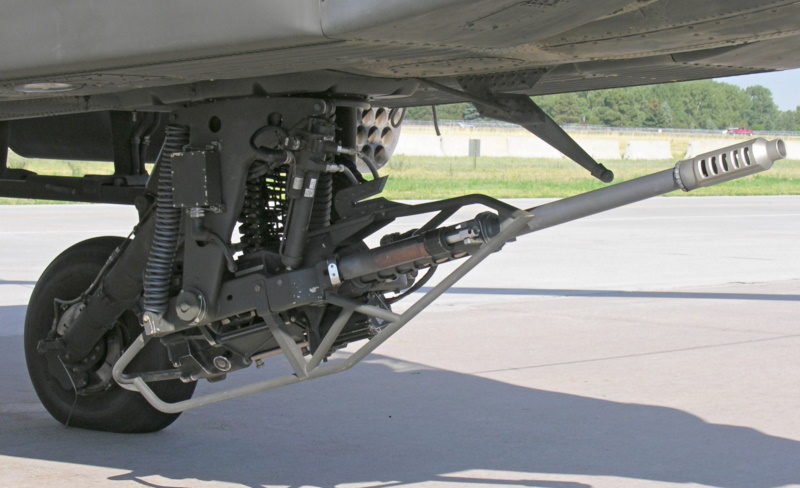
The Chain Gun was on a hydraulically-driven swiveling mount between the forward landing gear legs. It could be pointed 11 degrees up, 60 degrees down, and 100 degrees to either side. If hydraulics were lost, the cannon popped to its stowage position, with the barrel forward and up. There was a void in the nose above the cannon into which the weapon collapsed in a crash, reducing the likelihood of injury to the crew.
The stub wings could pivot up and down to provide some lift control and to aim stores, and automatically level themselves on landing to make life easier for armorers. The wings did interfere somewhat with hovering flight and, more significantly, could interfere with "auto-rotation", in which a helicopter that has lost power "flutters" to the ground as its rotor keeps on spinning. The wings generated lift that could keep the machine in the air while the rotors ran down, with the result of a harder impact in the end.
The Apache's primary external armament was the laser-guided AGM-114 Hellfire antitank missile, with a stated range of 8 kilometers (5 miles). The initial Army variant of the missile, the AGM-114A, soon gave way to the improved AGM-114C model. The Apache could carry a rack for four Hellfires on each stores pylon, giving a maximum warload of 16 Hellfires.
Another common load was the 19-round 70-millimeter (2.75-inch) "Hydra 70" unguided rocket pod. The rockets could be fitted with general-purpose blast-fragmentation, armor-piercing, flechette anti-personnel, smoke, illumination, or training warheads. Although unguided -- at least before the 21st century -- the gunner could set fuzing options for the standard blast-fragmentation warheads to provide a range of options for attacking different classes of targets -- contact detonation for targets in the open, delayed detonation for targets under cover, and timed detonation for "enfilade" attacks on targets hidden by terrain or other obstacles.
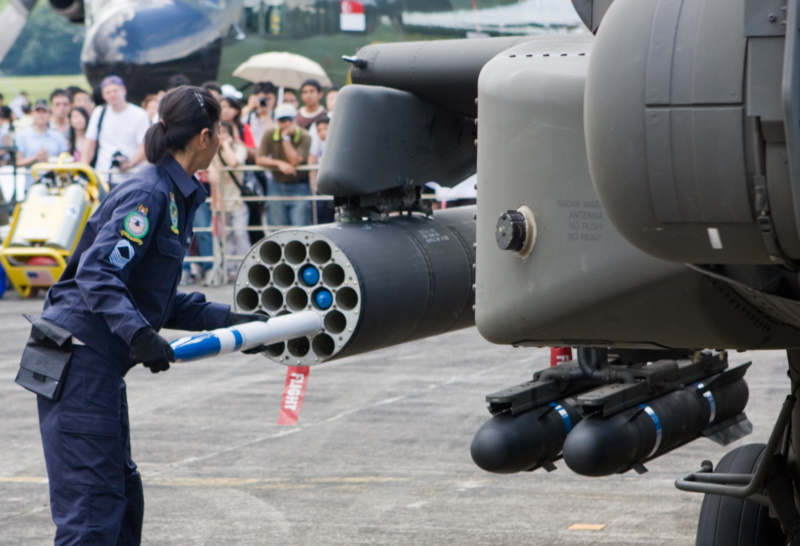
A mix of Hellfires, Hydra-70s, or other stores could be carried. The AH-64A could also be fitted with four 772-liter (204 US gallon) external tanks for ferry flights, giving the machine a range of 1,850 kilometers (1,150 MI / 1,000 NMI), impressive for a helicopter.
* The Apache's primary sensor suite was the "TADS/PNVS", where "TADS" stood for "Target Acquisition & Designation System" and "PNVS" stood for "Pilot's Night Vision System". It was a somewhat complicated multi-turret system fitted on a horizontal ring mount on the nose:
TADS/PNVS imagery could be backed up on a videotape recorder system for after-action / post-strike analysis, and for training purposes. The TADS/PNVS has a stabilization system, as well as fine and coarse aiming mechanisms. The sensor systems were somewhat maintenance-intensive, particularly because flight vibration could misalign them, undermining targeting accuracy. Ground crews spent a fair amount of effort making sure the systems were properly boresighted.
* The crew's primary interface to these sensor and targeting systems was the "Integrated Helmet And Display Sight System (IHADSS)", an early and somewhat bulky "smart helmet" with radio, laser-protective visor, and a "Helmet Display Unit (HDU)" known informally as the "hoodoo". TADS and PNVS could be "slaved" to the helmets, meaning the sensor (and, for TADS the laser target designator) followed the movement of the helmets. The Chain Gun could track TADS as well.
The gunner also had a joystick to control TADs and could direct TADS imagery to a small monochrome (green-black) display designated the "Optical Relay Tube (ORT)" instead of the hoodoo. The pilot had a similar but larger "Video Display Unit (VDU)" for PNVS imagery. It would seem logical as well that the pilot had a joystick for PNVS, but if so that is not clear from sources.
* The primary piece of countermeasures gear originally fitted to the AH-64A was the AN/APR-39(V)1 radar warning receiver (RWR), with antennas on the left side of the TADS/PNVS turret assembly and on the rear of the tailfin.
The AN/APR-39(V)1 was linked to a small circular display in the pilot's cockpit that gave the bearing of the threat. The RWR also activated an alert lamp and produced an audio alarm in the crew's earphones if the helicopter was being illuminated by a radar. Incidentally, there was a set of different audio alarms for a wide range of problems, such as "engine out", "IFF activation", and so on. The AN/APR-39(V)1 could be set to respond to specific emitters, or to any emitter it detected.
The AH-64A was later fitted with the improved AN/APR-39A(V)1 RWR, which featured a "threat library" that could identify a wider range of specific emitters. It could also produce audio warnings that describe the specific threat and give its direction. In addition, the AH-64A carried an AN/AVR-2A(V) laser detector to determine when the gunship was being "marked" by a laser designator, with this piece of gear also proving useful as a training tool to detect "fire" from laser-equipped adversary forces.
The Apache could be optionally fitted with M130 chaff dispensers on each side of the rear tailboom, with each containing 30 chaff cartridges. The M130s could also carry flares to distract heat-seeking missiles, but Apache crews traditionally relied on ground cover and not flares for protection since flares could hit the tail rotor and could set ground vegetation on fire. However, the AH-64A did have an AN/ALQ-144 "disco light" heat-seeker jammer mounted just behind the rotor head.
Other avionics included secure radios, "identification friend or foe (IFF)" systems, and a Doppler-radar based "Heading & Attitude Reference System (HARS)" for navigation. HARS was something of a weak point in the AH-64A's design, since it required at least six minutes to align itself before the start of a mission.
* During the early days of the program, MDD offered versions of the Apache to the US Marine Corps and the US Navy. Both versions would have had corrosion protection for seaborne operation, main rotor blade folding, more tiedown points, and improved electromagnetic interference protection. The Marines were very interested and conducted a two-week evaluation of the Apache in September 1981, including shipboard operation tests.
The Marine version would have not had the Chain Gun, but it would have been able to carry TOW antitank missiles, pods for Zuni 12.7-centimeter (5-inch) heavy unguided rockets (a favored USMC store), and AIM-9 Sidewinder air-to-air missiles (AAMs) or Sidewinder anti-radar missiles (SideARMs), with the Sidewinders fitted to wingtip launch rails. Sidewinder qualifications were performed with the Apache in 1987 and SideARM qualifications were performed in 1988. The Marines really liked the Apache, but the money simply wasn't there.
Incidentally, the US Army had some interest in the Sidewinder and SideARM trials, and also performed test firings of the "AIM-28 Air-To-Air Stinger (ATAS)" heat-seeking AAM in 1989. The ATAS was carried in a two-round pod, allowing carriage of four missiles. It lacked the range of the Sidewinder, but the Sidewinder also produced excessive smoke and flame when launched that announced the location of the gunship launch platform. Further firings were performed with the British laser-guided Shorts Starstreak / Helstreak AAM in 1991, which was also carried in a two-round pod.
The Navy "Sea Apache" version would have had a folding tail for shipboard storage; an AN/APG-65 maritime search and targeting radar replacing the TADS/PNVS turret and Chain Gun; a retractable in-flight refueling probe; and the capability to carry four Harpoon, Penguin, or other anti-ship missiles. The Navy didn't buy off on the concept, having little interest in dedicated helicopter gunships.
BACK_TO_TOP* The AH-64A's introduction to service was not entirely smooth. Unit costs had risen sharply from projections and made the Apache a target in Congress, though it also had its powerful defenders in the legislature. To make matters more difficult, it was of course a complicated machine and suffered its fair share of teething problems, particularly cracking of blades due to a manufacturing glitch, leading to bad publicity. System reliability for the Apache was initially only 3.83 hours, but given the complexity of the system that was expected, and in fact the specification required only an MTBF of 2.8 hours. The MTBF has crept upward to over four hours.
In service, the Army devised tactics in which Apaches operated in groups of four that could split into twin teams. They could operate in conjunction with "forward air controllers (FACs)" on the ground or in the air that spotted targets for the gunships, and cooperate with Air Force Fairchild A-10 "Warthog" tank-buster aircraft. Teaming the Apache with the Warthog resulted in a lethal combination that was substantially more effective than either weapon system operating on its own.
The first operational use of the Apache was in Operation JUST CAUSE, the American invasion of Panama to oust Panamanian strongman Manuel Noriega in late 1989. Their actual use in combat during this operation was somewhat minimal, though several were hit by ground fire and the gunships fired two Hellfires into Noriega's headquarters building.
The Apache came into its own during the Gulf War in 1991, when a US-led coalition drove the forces of Iraqi dictator Saddam Hussein out of Kuwait after his seizure of that country in 1990. In fact, the Apache began the air war of Operation DESERT STORM, as the effort was designated, on the dark hours of the morning of 17 January 1991, when they took out three Iraqi radar stations to allow air strike packages to fly through Iraqi air defenses undetected.
Apaches conducted further combat operations up to the beginning of the 100-hour ground war on 24 February 1991, when they went to work supporting the ground offensive. One US commander observed that he had expected the Apache crews to go through a learning curve in combat, but found that their peacetime training had made them perfectly competent at their lethal job: "The Apache crews quickly and methodically killed enemy formations in order of priority -- tanks with Hellfires, BMPs [Soviet-built infantry support vehicles] with rockets and 30-millimeter, and wheeled vehicles with 30-millimeter."
Some of the crews had never actually fired a live Hellfire before, with their training in that respect restricted to simulators. The training turned out to be effective, though the simulators were not perfectly accurate. Some of the crews were startled and frightened -- in combat, the two are about the same thing -- by the fact that the Hellfire had a two-second launch delay after pulling the trigger, and also generated a fair flash on launch. Simulators were modified after the war to provide more realistic behavior.
* 277 Apaches served in DESERT STORM. They destroyed about 500 Iraqi tanks, along with large numbers of other ground vehicles, artillery pieces, and nonflying aircraft. The campaign put an end to most of the doubts about the Apache.
The Apache continued to serve in the various "little dirty wars" of the post-Cold-War era. The AH-64A flew missions in the northern "no-fly" zone set up in Iraq after the conflict -- in principle to help protect the local Kurdish population from Saddam Hussein, though it didn't always work out that way. In 1995 and 1995, US Army Apaches were sent to Bosnia in the former Yugoslavia to help enforce a cease-fire between the warring factions there, which they did with a minimum of violence. The Apaches strongly helped emphasize that taking on the peacekeeping force in the country would be unwise, and nobody wanted to try it. The Apache served in the US intervention in Afghanistan from the winter of 2001:2002, providing major service in fighting with Taliban and al-Qaeda forces.
That was followed by the AH-64's service in the American invasion of Iraq in the spring of 2003. They suffered badly in the Iraq campaign, with all 32 Apaches dispatched to one attack shot up, and one of them shot down. This incident suggested to critics that the day of the crewed helicopter gunship was ending, with the Apache to be replaced by fixed-wing or rotary-wing robot gunships. Defenders of gunships replied that the fiasco was mostly due to unimaginative tactics, plus the fact that the enemy had been alerted that the Apaches were coming. They further pointed out that most of the shot-up Apaches were back in service in a short time, since the type had been designed to absorb significant battle damage and go on fighting.
BACK_TO_TOP* Although the AH-64A's service in the Gulf War in 1991 had been outstanding, the conflict still demonstrated clear deficiencies. The AH-64A's obsolescent analog navigation, sensor, targeting, and other avionics systems were simply not up to modern warfare. Apaches had to rely on special-operations Sikorsky Blackhawks and other platforms with modern avionics to lead the gunships to targets.
The Apache's Hellfire missile had also demonstrated some problems, for example in some cases homing off laser reflections from the sand and going into the dirt. The problems with the missile were quickly addressed. After the war, the Army fielded the improved "AGM-114K Hellfire II" variant, with a much smarter laser seeker and autopilot, more lethal warhead, and apparently longer range.
Improvements to the Apache itself proved a bit more time-consuming. MDD proposed an improved Apache designated the "AH-64B" in the later 1980s and the Army also considered a upgrade program -- but these efforts went nowhere, because new technologies were becoming available that rendered the proposed improvements obsolete before they got to the hardware implementation stage.
After the Gulf War, the new technologies finally seemed mature enough to allow an upgrade program to go ahead. An "AH-64A+" upgrade program was proposed as an incremental upgrade of 254 AH-64As, featuring new rotor blades; a new navigation system with a Global Positioning System (GPS) satellite receiver and a backup inertial navigation system (INS); engine sand filters, since the Gulf War had demonstrated the necessity of such things in a desert environment; secure communications; and a datalink.
However, the AH-64A+ was canceled in 1992, since the Army decided to go ahead with the much more capable "AH-64D" upgrade program. The development program for the AH-64D was given the green light in August 1990. Initial flight of the first of five AH-64D prototypes was on 15 April 1992, and a production contract was signed in 1996. Delivery of the first production AH-64D to the US Army was in the spring of 1997.
The AH-64D featured a largely revised avionics suite, including:
The AH-64D could be distinguished from the AH-64A by large "cheek" fairings to accommodate the new avionics. Electrical power capacity was doubled.
At the outset, the plan was that some of the AH-64Ds would also be fitted with a rotor-mast-mounted drum to support the "Longbow" system, used to target the improved AGM-114L Longbow Hellfire missile. The Longbow system included an "AN/APG-78 Fire Control Radar (FCR)" and an "AN/APR-48A Radio Frequency Interferometer (RFI)" passive emitter location system. The Longbow system provided a better all-weather / day-night targeting system than TADS, permitting engagements at longer range with much less risk of firing on friendly forces. There had been a number of such "friendly fire" incidents in the Gulf War, with Apaches scoring "kills" on US armored vehicles.
The mast mount for the Longbow also allowed the Apache to target adversaries from cover in the treetops, a tactic impossible with the nose-mounted TADs. There had been thought of mast-mounting TADS back in the beginning of the Apache program, but such a fit was judged beyond the technology of the time. The Longbow radar could handle twelve targets simultaneously, with Longbow Hellfires tracking targets autonomously after launch. Both ground and airborne targets could be engaged.
Comparative tests of the AH-64A and Longbow AH-64D were performed at Fort Hunter-Liggett in California in the spring of 1995, and demonstrated just how big an advance the AH-64D really was. AH-64As were credited with 75 kills of adversary targets, along with losses of 28 gunships and 34 kills on friendly targets. AH-64Ds scored 300 kills on adversary targets, losing only four machines and inflicting no "friendly fire" kills. A British officer who qualified on the AH-64D in 1996 described the contrast between the old and new variants: "There's just no comparison."
Early on, the Apaches with Longbow radar were designated "AH-64D Longbow" Apaches, while those without Longbow were simply "AH-64D". Confusingly, up to late 1993, the two updated variants were the "AH-64D" and the "AH-64C" respectively, but for whatever reason the Army decided not to use the AH-64C designation. The dividing line between the two subvariants was small; an AH-64D could be field-upgraded to the AH-64D Longbow configuration in a few hours.
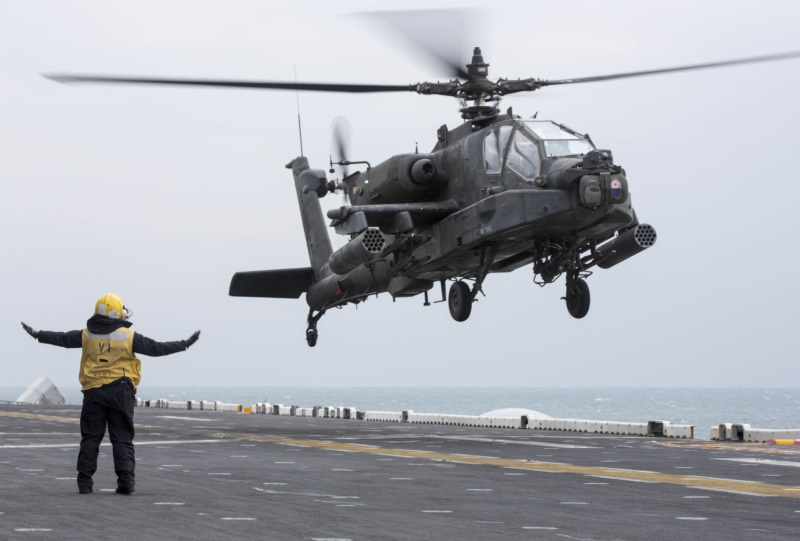
The Army decided to convert 501 AH-64As to AH-64Ds, with the last conversion delivered in 2006 -- with deliveries from 2003 being in the "Block II" configuration, followed quickly by the "Enhanced Block II" configuration. The Army then obtained 24 new-build machines, followed by 96 more updates, and finally 18 more new-build machines -- for a total of 639 AH-64Ds. Those AH-64As not upgraded to AH-64D spec were passed on to the Army National Guard to replace AH-1 Cobras -- to all be retired by the end of 2012. It appears that all AH-64Ds, at least eventually, got the Longbow targeting system.
Late production AH-64Ds got the T700-GE-701C turboshaft engine; it is not clear how many retrofits there were. In short, the configuration of the AH-64D evolved over time, and tracing out the changes is difficult. Significant upgrades included:
Arrowhead was required because the obsolete old system was no longer maintainable. The new system being a great improvement, with such features as a zoom CCD TV camera, a laser rangefinder and spot tracker, plus automatic target tracking and boresighting. Production began in late 2003, with service entry in 2005, and most or all the Apache fleet was refitted with it. Incremental upgrades were also provided for many of the AH-64D's systems. New stores were qualified for the Apache as well:
The US Army has demonstrated the Israeli Rafael Spike Non-Line-Of-Sight (NLOS) electro-optical missile system, with a range of up to 32 kilometers (20 miles). It is not clear whether there was any intent to field it with US forces.
* The Army had expected to acquire over 1,200 Boeing Sikorsky RAH-66 Comanche scout / attack helicopters to replace the Apache, but the Comanche program gradually ran out of steam, suffering cutbacks in 2002 and then getting the axe completely in 2004. That meant the AH-64D had to stay in service longer than previously expected, and in the summer of 2005 the US Army signed a "Block III" update program to keep the AH-64D Longbow Apache in service -- the AH-64D Block III being redesignated "AH-64E" in 2012. The AH-64E upgrade included:
The first upgrade to AH-64E Apache configuration, or "Apache Guardian" as it was named, performed its first flight in the summer of 2008. Low-rate initial production of the AH-64E begin in late 2010, with initial redeliveries in late 2011, and introduction to service in late 2013.
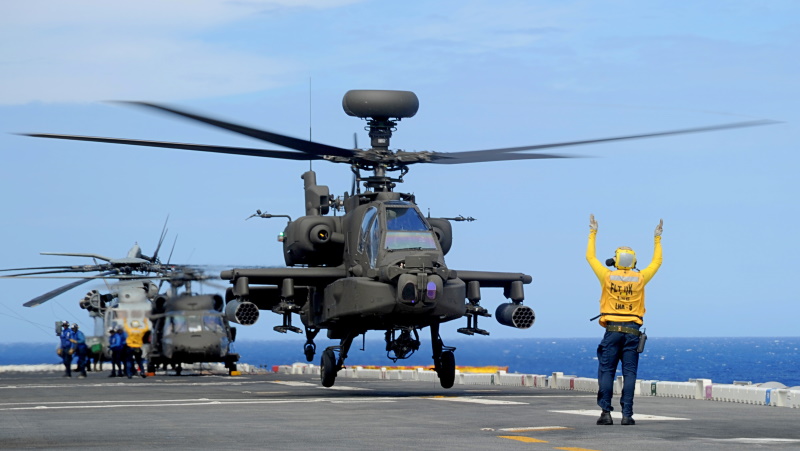
Other work is focused on improved software, in particular supporting the "Manned-Unmanned Teaming / Extended (MUMT-X)" scheme, allowing networking of the Apache with drones. The improved software also will support "littoral combat" modes on the Longbow radar, for operations in offshore operations. Boeing is investigating futures as well, options including:
The Army expects to field a fleet of 690 AH-64E Apaches to 2025, the bulk of them remanufactured, but with 56 new-build attrition replacements as well. The Army is not sure what comes after the AH-64E, balancing the prospect of an "AH-64F" against new technology emerging in the Army "Future Vertical Lift" development program, focused on next-generation high-performance rotorcraft.
BACK_TO_TOP* The AH-64A was exported to Egypt, Greece, Israel, Saudi Arabia, and the United Arab Emirates. The Israelis called the machine the "Petan (Cobra)", which was a bit confusing since they also obtained the Bell AH-1. They have used the Apache for attacks on Hezbollah fighters in south Lebanon and in their running squabbles with the Palestinians. A Petan shot down an Iranian drone penetrating Israeli airspace on 10 February 2018; this may have been the only air-to-air kill obtained by the AH-64 so far, the weapon of choice apparently having been a Hellfire.
The AH-64D also got sales on the export market. The Dutch ordered 30 AH-64Ds in 1995. They leased 12 US Army AH-64As for training in 1996, with first AH-64D delivery in 1998, and final delivery in 2003. Although the Dutch machines were delivered with a US-style defensive countermeasures suite, the Dutch decided that this fit was dated, and awarded a contract to Terma of Denmark to provide an updated countermeasures system. The suite was built around a Terma AN/ALQ-213(V) integrated threat controller, with new color cockpit threat displays, and new threat warning systems and flare dispensers. The new countermeasures suite was fitted to Dutch Apaches sent to Afghanistan for policing duties.
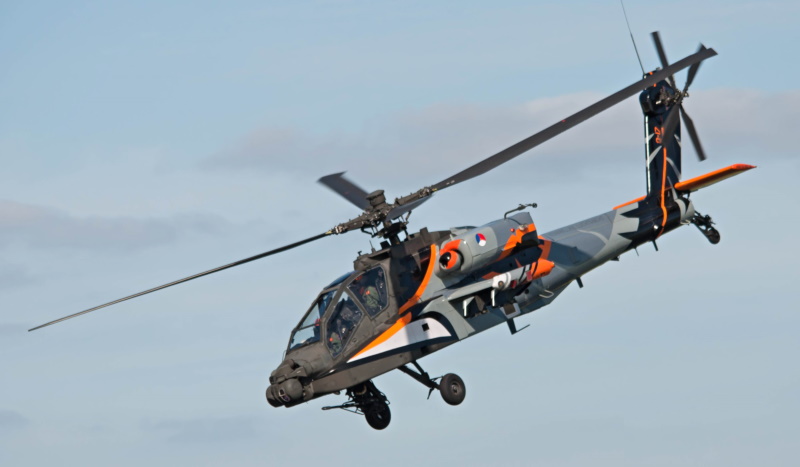
That was an interim fit, with a more formal update with such features as a laser-based heat-seeker jamming system being implemented from 2010. The Dutch obtained the Arrowhead M-TADS/PVNS upgrade as well. In addition to Afghanistan service, Dutch Apaches were sent into service in Mali in the spring of 2014 as part of a UN peacekeeping force. In 2017, the Dutch began an upgrade program to bring the 28 surviving AH-64Ds up to AH-64E standard.
Britain also ordered the AH-64D in 1995, with the first of 67 Briticized "WAH-64" Apache helicopter gunship for Britain's Army Air Corps performing its first flight at GKN Westland's Yeovil facility in July 2000. The first eight in the set were built by Boeing's Mesa, Arizona, factory, and the rest assembled from kits by GKN Westland at Yeovil in the UK. Introduction to line service was in May 2005, with the Army Air Corps having 16 in the inventory at the time, and deliveries were completed in 2007. The WAH-64 replaced the Westland Lynx in the anti-armor and attack roles.
The WAH-64 was somewhat different from the AH-64D Apache, having a number of unique features:
UK Apaches were refitted with the updated Arrowhead targeting system. The type had a high profile among the UK public since Prince Harry flew it with British forces in Afghanistan. One was lost in an accident there, with 16 more being mothballed as excess after the end of operations there in 2015. The British Army has been very happy with their Apaches; Britain ordered 50 AH-64E upgrades in 2016, with re-deliveries beginning in 2020, to be completed in 2023:2024. They will be armed not only with Hellfires, but with JAGM. There has been talking of using the British Brimstone, another Hellfire follow-on, but it hasn't happened yet.
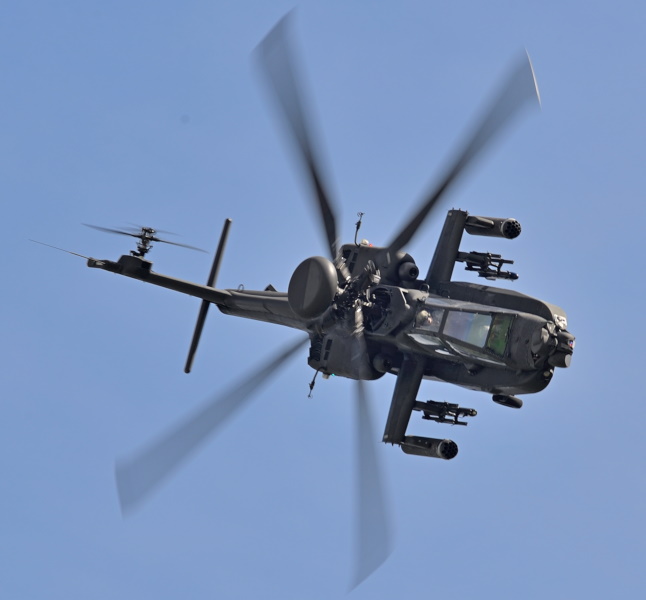
In 1999, the Japanese Defense Agency selected the AH-64D Apache to replace the Japanese Ground Self Defense Force's (JGSDF) 88 Fuji-Bell AH-1S Cobra helicopter gunships. The first Japanese Apaches, designated "AH-64DJP", were built by Boeing at the Mesa, Arizona, facility, and shipped to Japan, with the first deliveries taking place in early 2006. The rest were built under license by Fuji in Japan. The initial order was for seven Apaches, with 55 helicopters in the total order. The JGSDF wanted to replace their Cobras on a one-for-one basis, but the funds were simply not available.
The Egyptian Air Force obtained 45 AH-64Ds from 2003. Other nations that obtained the AH-64D include Singapore, Israel (along with upgrades from AH-64As), Kuwait, Greece, Saudi Arabia (with upgrades), and United Arab Emirates (all upgrades).
Taiwan was actually the first buyer of the AH-64E, ordering 30 in 2011, with other orders placed by:
Israel has performed an "AH-64D-1" upgrade on its machines, fitting them with improved defensive countermeasures, and a satcom capability: Singapore is working on a similar upgrade. Some sources claim over a thousand Apaches have been exported, but the actual total seems to be about 300.
BACK_TO_TOP* Sources include:
Information on current international deals was obtained from the Boeing website.
* Illustration credits:
* Revision history:
v1.0.0 / 01 aug 03 v1.0.1 / 01 aug 05 / Review & polish. v1.0.2 / 01 jul 07 / Review & polish. v1.0.3 / 01 jun 09 / Review & polish. v1.0.4 / 01 may 11 / Review & polish. v1.0.5 / 01 apr 13 / Review & polish. v1.0.6 / 01 mar 15 / Simplified export section, Qatar order. v1.0.7 / 01 feb 17 / Minor updates. v1.0.8 / 01 jan 19 / Review, update, & polish. v1.1.0 / 01 dec 20 / Illustrations update. v1.2.0 / 01 jun 22 / Review, update, & polish.BACK_TO_TOP
